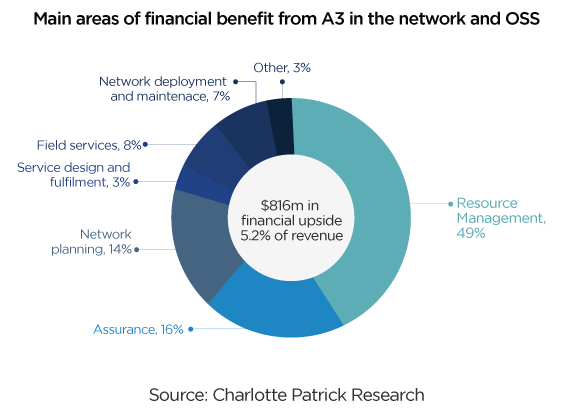The financial benefit of adding automation and intelligence in the network and OSS
Research into the financial value of deploying AI, automation and analytics (A3) into a telco network and OSS has just been completed. It shows a 5% upside to yearly revenues for an “average” telco with revenues of $16bn.
Resource management (including the virtualization of networks, more intelligence and automation in power management, new automations in the RAN and the move to intent-based networks) offers 50% of this potential value from A3.

Assurance will have the next largest impact, requiring sophisticated analytics and ML to manage large data sets and complete diagnostic/predictive tasks.
What is pushing forward the deployment of A3 in assurance?
A range of trends are pushing forward the deployment of A3 in assurance:
The need for observability – across customers
Over the last 10 years, increasing focus on service assurance has required new A3 to analyse data from individual customers or services in order to identify customer-impacting events. The continuing improvement in network resilience (coming from virtualization and new automations) is requiring less focus on individual network issues from the NOC and allows more focus on identifying and fixing service-impacting issues across the domains. Data from the network and a range of other sources (test data, weather patterns and customer sentiment) is needed, and these require new AIOps to deal with the increasing volume of data and undertake anomaly detection, prediction and optimisation tasks.
The need for observability – horizontally and vertically
Virtualized networks require assurance to span both enterprise IT and traditional telco networking, and 5G will increasingly blur the line between the two as enterprise workloads run on Multi-Access Edge Compute (MEC) at the network edge. Again, data sources increase, bringing the need for new AIOps models.
Assurance as part of service orchestration

Assurance and SLA support will be integrated with service orchestration, design and information from inventories. This allows the end-to-end automation of new services: the newly designed service will notify assurance about how network functions are chained together and the KQIs/SLAs required. The assurance platform will track compliance (are all metrics currently healthy?) and forecast potential threats to KQIs/SLAs.
Self-healing networks
Telcos face challenges in supporting dynamic networks with many more issues happening concurrently. The creation of multiple nested closed loops which poll in near-real-time; fixing issues discovered or requesting that orchestrators redesign the next-best configuration (either in terms of technical compliance or cost-effectiveness) if the issue can’t be fixed immediately (in the case of a fibre cut or hardware failure). This requires active assurance using AIOps models, time-series databases and storage/monitoring in a distributed architecture to support massive amounts of data from multiple domains.
Getting assurance data to enterprise customers and partners
Lastly, meeting enterprise customer requirements around new services will require telcos to integrate their data and operations with diverse and complex ecosystems. These integrations might provide data from telco assurance, inventory and other systems to enterprises or partners so that they can monitor the services they take from the telco. It could also become part of automations which extends from internal processes in the telco to the internal processes of the customer or partner. This complexity will require A3 to analyse and manage the data and processes.
Why has a significant financial upside been assumed for the deployment of A3 in assurance?
Significant financial upside is ascribed because:

Telco’s interest in delivering a diverse range of services, especially those with stringent SLAs requires them to understand an increasing range of service-impacting issues. Without increasing the deployment of AIOps, telcos would be unable to understand these issues

Assurance also plays an important role in the orchestration of service and networks. If telcos are to reach their goals around the autonomous network, then they will need increased integration of assurance data and
predictive/optimization models

The data from assurance systems is increasingly of interest to other parties outside of the NOC/SOC. For example, network architects (going into network planning tools to provide an understanding of where architectural changes might be needed) and, as above, provided to enterprise customers and partners to allow them to manage their telco services.
About VIA AIOps
VIA AIOps delivers the process automation capabilities to shorten the incident lifecycle and improve the overall service experience.
VIA’s total ecosystem observability, internet-scale noise reduction, machine learning based anomaly detection, and cross silo correlation transforms and optimizes operational practices. The result is lower costs, superior customer experience, and augmented intelligence to support a more efficient and effective operational staff.
Click here to learn more about the solution
